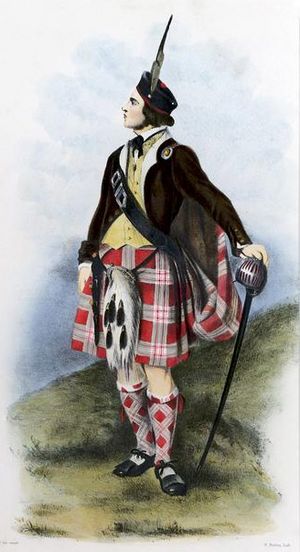Clan Menzies facts for kids
Quick facts for kids Clan Menzies |
|||
|---|---|---|---|
| Mèinnearach | |||
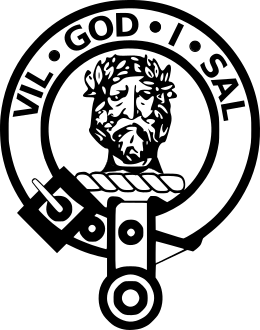
Crest: A savage head erased Proper
|
|||
| Motto | 'Vil God I Zal' God willing I shall | ||
| War cry | Geal 'us Dearg a suas (Up with the White and Red) |
||
| Profile | |||
| Region | Highland | ||
| District | Perthshire | ||
| Plant badge | The Menzies' Heath | ||
| Pipe music | Piobairreachd a' Mheinnearaich or the Menzies' March | ||
| Chief | |||
 |
|||
| Robert Ronald Menzies of that Ilk | |||
| (Am Meinnearach) | |||
| Seat | Castle Menzies | ||
|
|||
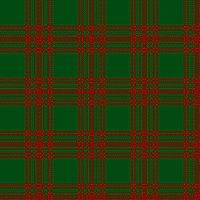
The Clan Menzies tartan in colors.
|
|
| Sett | |
|---|---|
| Tartan registries | |
| Scottish Tartans Authority | #894 |
| Scottish Tartans World Register | #894 |
| Scottish Register of Tartans entry | Clan Menzies |
Clan Menzies is a historic Highland Scottish clan. Its name is pronounced "Ming-iss". In Scottish Gaelic, the clan is called Clann Mèinnear, and a member is a Mèinnearach.
Contents
History of Clan Menzies
Where the Clan Came From
The Menzies family originally came from a place called Mesnières in Normandy, France. They arrived in England and then in Scotland.
Sir Robert de Myneris was an important person in the court of Alexander II of Scotland. He became a royal chamberlain in 1249. He was given lands in Glen Lyon and Atholl. His son, Alexander, received more land in 1296. Alexander also got the lands of Weem and married Egida, whose father was a powerful Scottish leader.
The clan's motto, "Vil God I Zal" (God willing I shall), comes from a battle in 1330. The clan chief, Lord Robert the Menzies, first said this phrase during the Battle of Teba. The clan's crest, which shows a savage head, also comes from this battle.
Fighting for Scottish Independence
Sir Robert, Alexander's son, was a close friend and fighter with Robert the Bruce. Robert the Bruce was a famous Scottish king. Because of his loyalty, Sir Robert was given more lands. These lands included areas like Glen Dochart and Glen Orchy.
The 1400s and 1500s
Another Sir Robert Menzies, who was the eighth chief, built Weem Castle around 1488. This castle is near the current Castle Menzies. In 1502, the castle was attacked by Stewart of Garth. This happened because of a land dispute.
The Menzies family asked the King for help. James IV of Scotland decided in their favor. The King made the Menzies lands into a special area called the free barony of Menzies in 1510. This gave the clan chief more power over his lands.
In 1540, James Menzies of Menzies married Barbara Stewart. She was related to Henry Stuart, Lord Darnley, who would later become a king.
The 1600s and Civil War
During a time of big conflicts in Britain, the Clan Menzies sided against Charles I of England. Because of this, the clan faced attacks from James Graham, 1st Marquess of Montrose. The Menzies chief was badly hurt in a fight.
His son, a Major in the Covenanter army, was killed in the Battle of Inverlochy. However, some Menzies families in the north fought with Montrose. Sir Gilbert Menzies of Pitfolds was with Montrose throughout his campaigns.
In 1665, Sir Alexander Menzies was given a special title, a Baronet of Nova Scotia. His brother, Colonel James Menzies, was known for surviving many serious injuries. The current chiefs are descended from James. Another brother of Alexander was killed in the Battle of Worcester in 1651.
The Menzies chiefs did not agree with the policies of James VII of Scotland. When James lost his throne in 1688, the Menzies chiefs supported Mary II of England and Prince William of Orange. However, some clan members, like Major Duncan Menzies of Fornock, fought against the government. They were part of the Highland charge at the Battle of Killiecrankie. Other Menzies clan members fought for the government.
The 1700s and Jacobite Risings
The chiefs of Clan Menzies did not support the Jacobite rising of 1745. This was a rebellion to bring the old royal family back to the throne. However, the Jacobite leader, Charles Edward Stewart, stayed at Castle Menzies for two nights.
A few days later, British forces, led by the Duke of Cumberland, took over the castle.
During the Jacobite rising of 1715, Menzies of Culdares supported the Jacobites. He was captured and sent away to America. He later came back to Scotland. In the 1745 uprising, he was too old to fight. However, he sent a fine horse to Prince Charles Edward Stuart.
The clan was active in the uprising under Menzies of Shian. He and his son were killed during the campaign. After the Battle of Culloden, the Menzies lands in Glen Lyon offered a safe place for people escaping the battle. This included some of Prince Charles's personal staff.
Clan Chief Today
The current chief of Clan Menzies is Robert Steuart Menzies of Menzies. He was born in 1965.
Clan Castles
The Clan Menzies has owned several castles over the years. Here are some of them:
- Comrie Castle is a ruined castle near Aberfeldy in Perthshire. It was built by the Menzies family. The castle was burned in 1487. The clan then moved to Weem, which is now Castle Menzies. However, Comrie was still used by some parts of the clan until about 1715.
- Castle Menzies, also known as the Palace of Weem, is near Aberfeldy, Perthshire. It's a large, strong house with a special Z-shape design. The original palace was built after 1487. It was attacked fifteen years later. In the 1650s, soldiers from Oliver Cromwell's army lived there.
As mentioned, the clan chiefs did not support the 1745 Jacobite rising. Even so, the Jacobite leader, Charles Edward Stewart, stayed there for two nights. Just four days later, British forces took over the castle. During World War II, the castle was used to store medical supplies for the Polish Army. It later became run down. In 1957, the Menzies Clan Society bought it. They have been working hard to restore it.
- Meggernie Castle is north of Killin, Perthshire. It was first owned by Clan Campbell. It then passed to the Menzies of Culdares family. This family supported the Jacobite cause. There's a spooky story that the castle is haunted. It's said to be haunted by the ghost of a wife who was cut in half by her jealous husband. People say the upper floors are haunted by the top half of her body. The lower floors and burial ground are haunted by the bottom half.
- Pitfodels Castle was near Aberdeen. Not much of it is left today. A new building, Norwood Hall, replaced it. The castle was first owned by the Reids. It passed to the Menzies family in the 1500s through marriage. The Menzies of Pitfodels family also supported the Jacobites. This family helped start the Catholic College of Blairs.
- Culdares is near Fortingall, Perthshire. This was the location of a castle or old house. It was the home of the Menzies of Culdares branch of the clan.
Clan Tartans
Tartans are special patterns of woven cloth. Each Scottish clan has its own unique tartan. Here are some of the tartans associated with Clan Menzies:
| Image | Tartan Name | Notes |
|---|---|---|
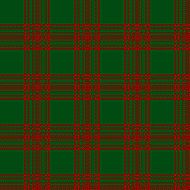 |
Menzies | This pattern comes in different colors, but the basic design is the same. The red and green version is also called the Green Menzies. |
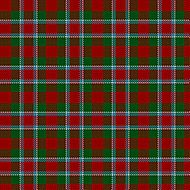 |
Menzies #2 | This tartan pattern is very old. It was recorded by weavers in the 1700s. Some experts believe it might be the oldest Menzies tartan. |
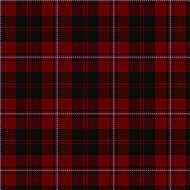 |
Menzies of Culdares | This specific tartan design was found from an old portrait at Castle Menzies. |
 |
Menzies 1938 | This tartan comes from a book published in 1938. In 2006, the clan considered it their mourning tartan. |
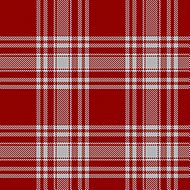 |
Menzies 1815 | This red and white Menzies tartan was once mistakenly called MacFarlane. However, the clan chief confirmed it as a Menzies tartan around 1816. It can be found in red, green, black, and white. |
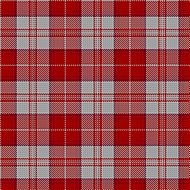 |
Menzies #3 | This tartan is listed in a book from 1842 called 'Vestiarium Scoticum'. This book is the source for many clan tartans. |
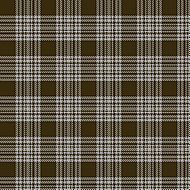 |
Menzies Brown White | A sample of this tartan is found in old weaving company collections. |
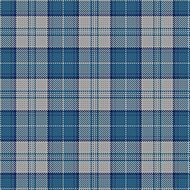 |
Menzies Dress Blue & White | This tartan was sold by a retailer in Edinburgh. |
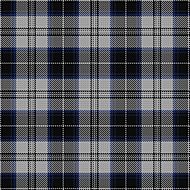 |
Menzies Black Dress | This design comes from a weaving company in Selkirk. |
 |
Menzies Hunting | This tartan was recorded in 1906. It comes in various colors, but the official version is red and black. It was also mentioned in a book about old and rare Scottish tartans from 1893. |
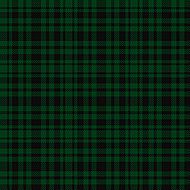 |
Menzies Green | This tartan is part of a collection kept in the Scottish Tartans Society archive. |
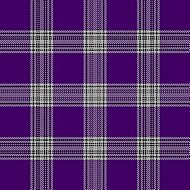 |
Menzies Mauve and White | This tartan is from the Paton collection. |


